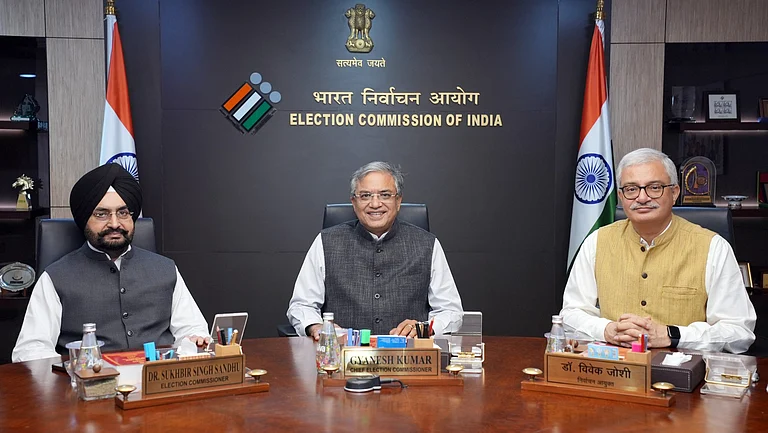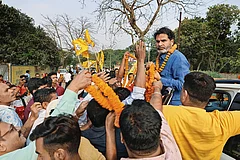
The primary ground of challenge was that the Bihar SIR ignored the roll revisions undertaken by the ECI up to January 2025 and instead went back to the electoral roll as it stood after the 2003 intensive revision.
The SIR is a hark back to 1997 Assam, where the ECI by its circular dated July 17, 1997, directed a survey of the electoral roll to mark ‘D’ or ‘Doubtful’ against the names of voters found missing or absent.
The unholy nexus between NRC and CAA is still to be argued before the Supreme Court—that the NRC will demand documents to prove citizenship
The nationwide ‘Special Intensive Revision’ (SIR) of electoral rolls was announced by the Election Commission of India (ECI) by its circular dated June 24, 2025, with the first phase to be conducted in Bihar ahead of the assembly elections to be held in November this year. A number of writ petitions were filed before the Supreme Court challenging the SIR as being in excess of the powers of the ECI under the Representation of the People Act, 1950.
The primary ground of challenge was that the Bihar SIR ignored the roll revisions undertaken by the ECI up to January 2025 and instead went back to the electoral roll as it stood after the 2003 intensive revision as the baseline. All those voters who were not part of the 2003 electoral roll were asked to submit one or more of 11 documents identified by the ECI as proof of citizenship. But since citizenship of India is a pre-requisite for being a voter under Article 326 of the Constitution of India, what is wrong with asking potential voters to prove their citizenship?
The answer lies in the fact that the Representation of the People Act, 1950 and the Registration of Electors Rules, 1950, prescribe that inclusion in the electoral roll will be based on a self-declaration of citizenship backed by one of six documents prescribed in Form 6 of the 1950 Rules—birth certificate, matriculation certificate, passport, Aadhaar card, PAN card and driving license. The SIR notification effectively alters this requirement without amending the statute and the rules. The ‘Enumeration Form’ prescribed by the June 24 circular demands one of 11 documents to back the claim for inclusion. These 11 documents are a departure from the six documents prescribed in Form 6 of the 1950 Rules, of which Aadhaar card, PAN card and driving license are conspicuously missing in the list of 11. Further, the Supreme Court in 1995 in its judgement in Lal Babu Hussein had held that once a voter has been included in the electoral roll, s/he cannot be removed, except by an enquiry into the citizenship of the individual voter and giving them an opportunity of hearing. The SIR is an overreach of the decision of the Supreme Court as it ignores the several roll revisions since 2003 and places the onus on voters who were included in the electoral roll between 2003 and 2025 by the ECI itself as part of periodical roll revisions to prove their citizenship.
The ECI sought to justify going back to the 2003 electoral roll claiming that was the last ‘intensive’ revision that was carried out in Bihar, and all subsequent revisions, were ‘summary’ in nature. But whether a revision is ‘intensive’ or ‘summary’ under the 1950 rules depends on whether it redraws the entire electoral roll from scratch or just revises an existing roll with additions and deletions. It is not as if those voters who are included in a ‘summary’ revision are subjected to a less rigorous process, since the standard for inclusion is the same across varieties of revisions. In any event, the rules do not contemplate a revision that is midway between intensive and summary—in that it does not redraw the entire roll, but instead, is a revision of a randomly selected electoral roll from 22 years ago.
The reason for the hue and cry is that the present exercise, which is outside the pale of both the statute and judicial precedent, has effectively deleted voters from the electoral roll based on doubts cast by the ECI on their citizenship. The ECI is not a body empowered to go into questions of citizenship, a power which lies with the Union Ministry of Home Affairs, Government of India and the Foreigners Tribunals created under the Foreigners Act, 1964. It is also a disturbing reminder of the Assam experience where a controversy started by suspicions of illegal immigrants being included in the electoral rolls triggered a violent movement that carried in its wake the Nellie massacre, which saw the slaughter of 2,191 people (according to official figures), finally ending in the Assam Accord, and eventually resulting in the exercise to compile the National Register of Citizens (NRC) in Assam in 2019. The Assam NRC has rendered 19 lakh citizens stateless, whose fate remains uncertain till today. The Home Minister had promised a nationwide NRC on the floor of Parliament in his now famous “aap chronology samajhiye” speech at the time of the passing of the Citizenship (Amendment) Act, 2019 (CAA), which resulted in countrywide protests and led to communal violence including in Northeast Delhi.
The SIR is an overreach of the decision of the Supreme Court as it ignores the several roll revisions since 2003 and places the onus on voters.
The SIR is a hark back to 1997 Assam, where the ECI by its circular dated July 17, 1997, directed a survey of the electoral roll to mark ‘D’ or ‘Doubtful’ against the names of voters found missing or absent. The ECI directed that those voters who were branded ‘doubtful’ should be put on trial before the Foreigners’ Tribunals. According to reports, 3.7 lakh voters were marked ‘doubtful’ in this exercise, and the saga of trials and appeals is still continuing till this day, with several thousand undertrials being placed in detention centres created for this purpose, and there is no clarity on what is to become of persons who are declared ‘illegal immigrants’ by the Foreigners Tribunals, since Bangladesh does not accept these persons as its citizens.
There are other ways in which the Bihar SIR is reminiscent of the NRC exercise in Assam. The Assam NRC also accepted electoral rolls up to a previous date, in that case March 24, 1971, as a valid presumption of citizenship. There too, reliance was placed on family tree and relationship documents to establish relationship with a family member whose name was included in the roll prior to the cut-off date. The list of 11 documents mentioned in the SIR ‘enumeration form’ also has significant commonalities with the documents accepted in the Assam NRC, such as land records, post-office/LIC/bank account records, permanent residence certificates issued by state authorities and record of enumeration in a previous NRC itself. As was argued before the Supreme Court, most of these documents are available only with a miniscule percentage of the population, whereas commonly available documents such as Aadhaar and ration card were not included in the list.
As per the ECI’s press release, dated September 30, 2025, 65 lakh voters whose names were included in the electoral roll at the commencement of the SIR exercise were omitted from the draft roll published on August 1, 2025. Thereafter, several voters whose names were included in the draft roll were served show cause notices stating that ‘doubts’ had arisen on their right to be included in the electoral rolls and they were asked to appear in person with documents to prove that they were entitled to be included in the electoral roll. The basis on which these notices were served was not made clear, nor did the notices themselves indicate how this ‘doubt’ arose. Eventually, 3.66 lakh such persons/voters were deleted from the final electoral roll, with no order made available in the public domain giving the reasons for their deletion. This is almost exactly the same number that was marked ‘D’ in 1997 in Assam. There is no clarity on what is to become of these persons and those from amongst the 65 lakh voters omitted from the draft roll itself who may actually be present in the state.
Meanwhile, while the Supreme Court is still seized of the petitions challenging the constitutional validity of the CAA, a new Immigration and Foreigners Act, 2025, has been passed by Parliament and has come into force from September 1, 2025. Under the new Act, an Immigration and Foreigners (Exemption) Order, 2025, has been simultaneously promulgated on the same date whereby the restrictions on illegal entry/presence in India have been relaxed for citizens of Nepal, Bhutan, Tibet and Sri Lanka, in addition to persons other than Muslims belonging to Afghanistan, Pakistan and Bangladesh who were already covered under the CAA. However, the cut-off date for entry into India of the latter category has been extended from December 31, 2014 under the CAA to December 31, 2024 under the Exemption Order.
So ironically, while the unholy nexus between NRC and CAA is still to be argued before the Supreme Court—that the NRC will demand documents to prove citizenship from all persons present in India and render those who are unable to produce documentation stateless, while the CAA will bring all excluded persons other than Muslims back into the pale of citizenship—a similar exercise of questioning citizenship is being undertaken by the ECI in the form of SIR while the safety net has become wider still under the new Immigration and Foreigners Act, permitting all non-citizens to remain in India, except Muslims from Pakistan, Afghanistan and Bangladesh.
This begs the question: Is the SIR a new avatar of the NRC by another name, being pushed through under the garb of cleansing the electoral rolls? Although the legal validity of the SIR is still to be adjudicated by the Supreme Court, the Court has already allowed the exercise to go to completion in Bihar. The June 24, 2025, circular had already declared that Bihar was just the first phase of the SIR and the same exercise is now to be undertaken in the rest of the country, starting with West Bengal. The framework to deal with persons whose citizenship may be marked ‘doubtful’ in this exercise is already in place, and the safety net has been cast wide to effectively ensure that non-Muslim ‘illegal immigrants’ are not visited with any adverse consequences. If this is true, then the Bharatiya Janata Party (BJP) has pulled off a masterstroke, bringing in through the back door without much ado a framework which by its original name had caused a furore in the country just six years ago. But much like a rose, a net of thorns by any other name would still sting as hard. The coming months will reveal the design behind the SIR and what its nexus is with the Immigration and Foreigners Act. By then, one hopes it will not be too late.
(Views expressed are personal)
MORE FROM THIS ISSUE
Saiyyad Mohammad Nizamuddin Pasha is a Delhi-based lawyer
































